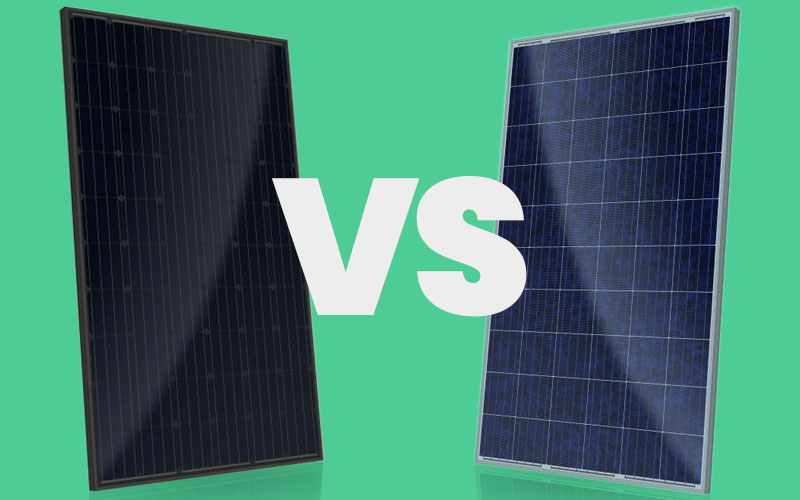Are you thinking of installing solar panels for your home? Before you start your home solar energy project, you have a decision to make: should you buy blue solar panels or black solar panels?
I think it's safe to say you saw a lot of blue solar panels on the roof. After all, blue panels have always been the most popular type of solar panel.
But you may also have noticed that some solar panels have a more stylish black look; these have become more common in recent installations.
But which is the better choice? We'll detail each type of solar panel to help you make an informed decision.

Different types of solar panels
It’s not really a matter of color. It’s actually the quality and the method of manufacturing blue and black solar panel cells that make them look slightly different from one another.
Read on to learn how they are made and what gives each its distinctive appearance.
What are BLACK solar panels?
The term ‘black solar panels’ almost always refers to monocrystalline panels that look black to the eye. They are made from a single, high-quality silicon crystal. This silicon has a higher level of purity as compared to the silicon crystals used in blue polycrystalline solar panels.
*While there is another type of black module - ‘thin-film solar panels’ - their market share is tiny. As such, for this blog we’ll take black panels to exclusively mean monocrystalline panels.
How black solar panels are made
Black solar panels use monocrystalline solar cells, which are made through the czochralski process. This process uses a silicon crystal seed that is placed in a vessel or vat of molten silicon. The silicon crystal seed is slowly drawn out, along with the molten silicon, forming a block of solid crystal silicon. The silicon block is then finely sliced into silicon wafers, which are used as solar cells for energy production.
Although black and blue panels are produced almost the same way, light interacts with a single-crystal (monocrystalline) cell differently than a cell comprised of many crystals (polycrystalline). This causes black solar panels to have a uniform appearance that looks black to the eye.
The whole process of making a single-crystal black cell is comparatively more complicated than producing multi-crystalline blue solar cells. Also, a significant amount of the pure silicon is wasted in the production of black solar cells, as all the four sides of silicon wafers are chopped off to get the shape of the cells right.
What are BLUE solar panels?
The term ‘blue solar panels’ is used to refer to polycrystalline solar panels. Unlike a monocrystalline silicon cell, a polycrystalline cell is created from more than one raw silicon crystal.
How blue solar panels are made
The process of making blue-colored panels is very similar to that of producing black solar panels. However, the step of drawing up the silicon crystal seed (used to form black monocrystalline solar cells) is skipped in the case of blue solar cells.
The silicon crystals, melted and poured into the vat, are simply allowed to cool to form polycrystalline silicon cells. This forms distinctive grains and edges on the blue solar cells.
The way that the polycrystalline cells reflect light, combined with the anti-reflective coating that is applied to them, give these solar panels both their blue appearance as well as a bit of a glimmer.
Advantages of blue and black solar panels
Which solar panel is right for you? This decision depends upon a number of factors, including your budget, your space, as well as a few other points, all highlighted below.
The case for black solar panels
More energy efficient
The uniform alignment of silicon crystals in a monocrystalline panel makes these panels more energy efficient. You typically require fewer black solar panels than polycrystalline solar panels to generate the same amount of energy, making black solar panels the better option when it comes to saving space.
Black solar panels offer superior performance - and most people think they look a lot better, too.
Absorb more light
In addition to energy efficiency, black panels also absorb more light than blue ones. This means that black panels are capable of absorbing more sun rays, thereby generating more solar power. This leads to more energy being produced for your home or business.
Better performance in warm weather
Black monocrystalline solar panels perform better in warmer weather. With all solar cells, electricity production falls as the temperature rises. However, this output degradation is less severe in black panels as compared to blue panels.
Space-saving design
Black solar panels are space-savers. As monocrystalline solar cells are more energy efficient, you require fewer monocrystalline solar cells than polycrystalline solar cells to generate the same amount of energy.
Bonus features
They last longer – with many manufacturers offering a 25-year warranty.
Black solar panels also tend to perform better in low-light conditions.
The case for blue solar panels
More cost-effective
Polycrystalline cells were previously thought to be inferior to monocrystalline cells because they were slightly less efficient. However, because of the cost-effective method of producing polycrystalline solar cells, they emerged as a dominant technology for the residential solar panels market.
Less expensive to create and repair
Because blue solar panels are easier to produce, they are also less expensive. Both their upfront and installation costs are significantly cheaper as compared to black solar panels. They're also used more commonly, so repairs are quick and easy.
Blue solar panels are less aesthetically appealing, but are cheaper.
More eco-friendly
The blue polycrystalline solar panel cells produce less waste in the manufacturing process as compared to the monocrystalline cells.
In manufacturing monocrystalline cells, a significant amount of silicon ends up as waste as silicon wafers are chopped off from all four sides. As polycrystalline cells do not require any individual shaping, very little waste is produced.
If you're concerned about your ecological footprint, this might be something you want to consider.
Blue or black panels: Which is the best for your home?
The differences between blue and black solar panels on the market today go far beyond their color and aesthetic appeal. In fact, the color of a solar panel indicates the grade of silicon it's made of.
Here’s a quick summary to help you choose the right one for your home!
Black/monocrystalline solar panels
Characterized by smooth, black appearance and high-quality silicon
Occupy less space and have a longer lifespan
Formed through energy-intensive production process which generates a lot of waste
Carry a higher price tag for installers and consumers
Blue/polycrystalline solar panels
Characterized by visible crystals, more scattered look, and lower-quality silicon
Require slightly more space for producing the same amount of energy as black panels
Less complicated production process with minimal waste production
More affordable
Whether you choose black or blue panels, going solar is a good decision
To learn more welcome to contact us: Josie.liu@eastluxenergy.com


